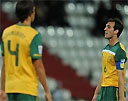 Over the weekend, as the English Premier League took off for another season, England’s The Daily Telegraph newspaper featured an insightful tactical yarn looking into Andre Villas-Boas’ philosophy.
Over the weekend, as the English Premier League took off for another season, England’s The Daily Telegraph newspaper featured an insightful tactical yarn looking into Andre Villas-Boas’ philosophy.
It’s a piece of football literature that should be an essential resource at any management course, cut up and discussed in absolute detail.
In it, the new Chelsea manager talks about some of the fundamental steps to controlling a football match. It emphasises how the dynamics of a formation, rather than the formation itself, make all the difference.
It is an argument that resonates strongly with this correspondent, especially having watched and analysed Jan Versleijen’s 4-3-3 at both the Under 17s and Under 20s World Cups recently.
For the Joeys and Young Socceroos, it was never the formation that was the problem, but rather Versleijen’s use of the formation, and his inability to get it functioning in an in-synch way.
Villas-Boas’ philosophy is timely then, reinforcing how crucial it is to get the detail and dynamics right in order to have a functioning unit able to control football games through tactical acumen.
He explains, for example, how a traditional (or flat) midfield four, built around two central midfielders, one who stays, one who pushes on, is very different to a midfield diamond four, where there is a defined attacking midfielder and a defined holder (or pivot).
He explains how a diamond gives you greater impetus going forward but how its narrowness also has the potential to expose you defensively, in the wide areas.
Nowhere was the latter point more obvious that in the first half of the Young Socceroos 5-1 loss Spain at the Under 20s World Cup.
There Versleijen moved away from the now-mandated 4-3-3 that he had used in the first two games in Colombia and ever since taking control of Australia’s youth teams.
Apart from the lack of familiarity to the players, I’d suggest it was the manager’s application of the diamond midfield rather than the diamond midfield itself that was at fault in Manizales.
Versleijen, I’d argue, erred in using two wide players, built for a 4-3-3, in Tommy Oar and Kofi Danning, as his left and right midfielders respectively.
Rather then start out wide and high, where they are comfortable, they were asked to tuck in and get close to the two central midfielders, attacker Mustafa Amini and holder Terry Antonis.
As well, there was a significant disconnect between the diamond midfield and the back four, which meant there was a substantial gap between the two lines, space the gifted Spaniards had a field day in.
In truth, this disconnect between the defensive line and the rest of the team is an issues that has been synonymous with Versleijen’s sides all along, even at his most successful sojourn, the Under 19s Asian Cup last year.
Again, it’s all about the dynamics and the detail.
Diamond midfields that have been more successful in Australia in recent times have featured more industrious “wide” players that feel comfortable closer to the middle of the park, as well as fullbacks prepared to step up regularly and join the midfield line.
The first that comes to mind was Sydney FC’s formation during their title winning 2009/2010 season, where Karol Kisel was deployed on the right and Terry McFlynn on the left. Tucking in and working closely with Steve Corica (and later Mark Bridge) and Stuart Musialik, they provided the requisite defensive cover, as well as joining in forward transition.
Last season it was the functional Central Coast Mariners that came within a whisker of the championship in that epic grand final. Graham Arnold’s diamond featured Oliver Bozanic on the left and Michael McClinchey on the right, as well as progressive fullbacks in Joshua Rose and Pedj Bojic.
Another example Villas-Boas cites is the difference between Barcelona’s 4-3-3 and others. He talks about how Barcelona’s front men drop from the front line and play between the lines.
The prime example here is Lionel Messi, who you often see dropping into midfield, where he likes to face the opposition and start the play, either linking with team-mates of flying solo, ball firmly attached to his feet.
Villas-Boas argues this wouldn’t work in England.
There, he says, midfielders like Frank Lampard and Steven Gerrard don’t want attackers to drop into the midfield. This denies them space and stops their chief weapon, their forward drive.
It all makes for riveting reading, giving an insight, among many other things, into just how different a formation can look and function, even if it’s the same formation on paper.





























































































